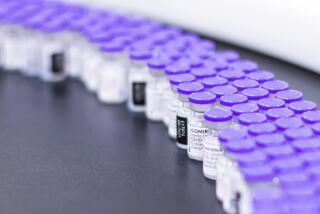Last year’s flu vaccine: All in all, not so bad
- Share via
It was thrown together in a hurry, only aimed to protect against one strain of influenza, and arrived on the market well after the novel flu virus had gained a foothold in the general population. But last year’s vaccine against the novel H1N1 flu, in the final analysis, worked pretty well, according to a European study published Tuesday in the journal Public Library of Science (PLoS) One.
The study, which tested the effectiveness of the H1N1 flu vaccine at surveillance sites scattered across Europe, found that a single dose of H1N1 flu vaccine, which was offered as a shot and in mist form, was 71.9% effective in protecting against infection with the H1N1 virus. In patients younger than 65 years old, that effectiveness level rose to 78.4%; for patients of all ages who were free of chronic disease, it stood at 72.9%.
That compares well to the average effectiveness of seasonal influenza vaccines, which, in a healthy population under 55 years old, are thought to protect against influenza infection between 70% and 90% of the time. The performance of the H1N1 vaccine is especially remarkable because the H1N1 virus emerged as a public health threat suddenly in April 2009, giving world health officials and manufacturers only a few months to design, produce and distribute the vaccine against it.
By late October and early November, when the 2009-2010 novel H1N1 vaccine became widely available, the virus was spreading quickly throughout Europe and North America. As a result, many patients were likely exposed to the virus after getting the vaccine but before their bodies were able to mount an immune response -- a process that takes at least two weeks. That timing hitch may have driven down the vaccine’s apparent effectiveness, said Lone Simonsen, an epidemiologist with George Washington University and an expert on influenza, in an interview Tuesday.
“Still, said Simonsen, “that is a good result for a pandemic vaccine program.” She added that the current season’s flu vaccine, which was designed to protect against the H1N1 flu as well as two other strains of influenza virus widely circulating, will likely be more effective because it has been on the market longer. That allows patients who get the vaccine more time to develop immunity against circulating strains of flu.
In the United States, the Centers for Disease Control and Prevention estimates that between 43 million and 89 million people became ill with the H1N1 flu during the 2009-2010 season, with 12,470 dying and 274,000 hospitalizations.







